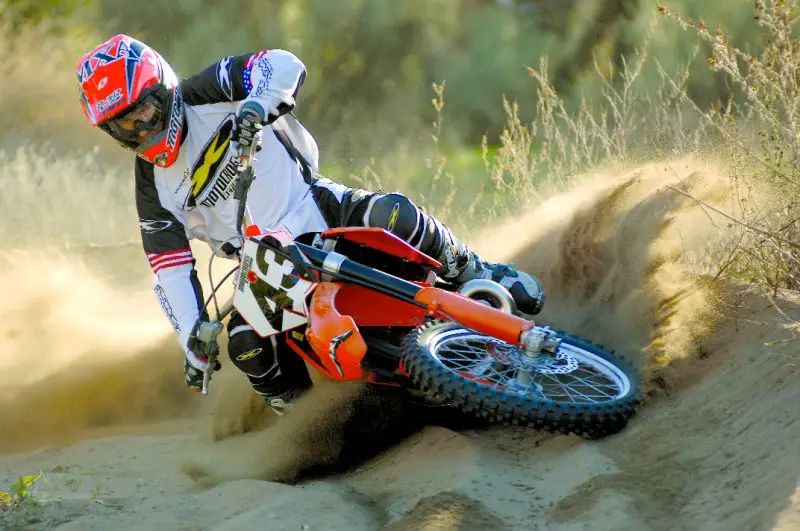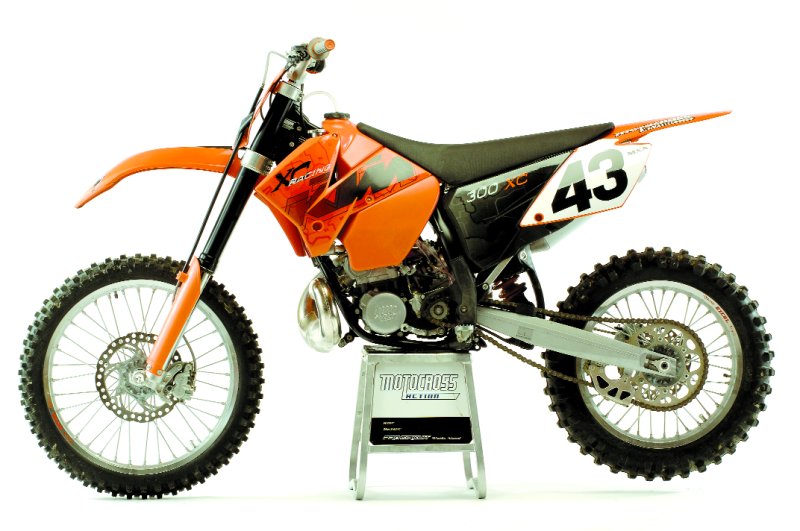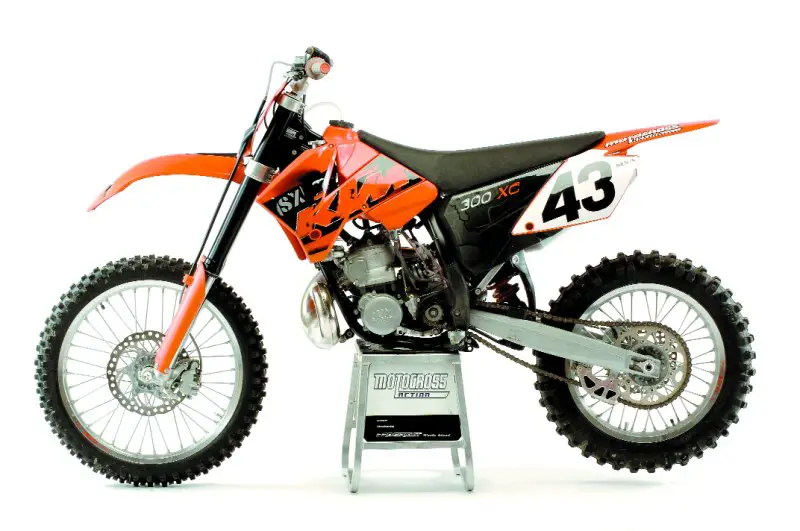WE RIDE KTM’S VERSION OF THE 300XC
ÿ
 ÿ
ÿ
Common sense: In a perfect world the AMA would allow 250 two-strokes to be over-bored to compete against 450 four-strokes.
KTM IS THE ULTIMATE NICHE MARKETEER. INSTEAD OF TRYING TO COMPETE HEAD-TO-HEAD AGAINST THE JAPANESE POWERHOUSES IN THE TRADITIONAL 125, 250 AND 450 CLASSES, KTM HITS THEM WHERE THEY AIN’T.
You may not give KTM much thought in relation to Suzuki, Yamaha, Kawasaki or Honda, but you should. KTM sold close to 20,000 offroad motorcycles in America last year. Yes, we know that you don’t see that many at motocross races, but don’t be fooled. The little Austrian firm cranks out a lot of machinery. In fact, KTM offers eight different full-size two-stroke competition models and another six minicycle models (ranging from 50cc to 85cc). And that’s just two-strokes. They also offer 12 distinctly different four-strokes. Even more telling is KTM’s incredible variety in displacement sizes. There are KTM engines in 50, 65, 85, 125, 200, 250, 300, 400, 450, 525, 560, 625 and 950cc versions. So, where are all of these KTMs if they aren’t at motocross tracks? Apart from the Pee-Wee class, they are racing enduro, cross-country, hare scrambles, supermoto, rallye and desert races.
An accurate count of KTM’s complete product line is almost impossible, because it is constantly changing to meet whatever category needs their attention. KTM is the ultimate niche marketeer. Instead of trying to compete head-to-head against the Japanese powerhouses in the traditional 125, 250 and 450 classes, KTM hits them where they ain’t. Even though the average sales of most of KTM’s models are less than 1000 units each, they offer so many different types of bikes that the sum of all the columns adds up to a healthy player in the offroad world.
It’s no secret that KTM doesn’t depend on motocross bikes to meet their bottom linetheir bread-and-butter bike is built for cross-country racing (whether enduro, hare scrambles or desert racing). And you can’t help but be impressed by the vast number of engine sizes to choose from in the KTM catalog. That’s when the light bulb went off in the feeble minds of the MXA wrecking crew! Why are we beating our heads against the wall trying to keep up with the new breed of 50-horsepower, 450cc four-strokes with our mid-sized 250 two-strokes when KTM is already building the perfect two-lung engine size. The only problem: KTM’s 300cc two-stroke mill does not come in a motocross version. Instead, it is housed in the chassis of a bike with cross-country nomenclaturethe KTM 300XC.


Stocker: For its’ cross-country purpose the KTM 300XC comes with a large capacity gas tank.
WHAT IS AN XC? FIRST OF ALL, IT’S NOT A MOTOCROSS BIKETHEY ARE SX AND SXF. SECONDLY, IT IS NOT AN ENDURO BIKETHAT IS AN EXC. THIRDLY, IT IS NOT A SUPERMOTO BIKETHAT IS AN SMR.
Not counting fans of Trivial Pursuit, there is no one on the planet who can keep track of KTM’s alphabet soup of motorcycle designations. As motocrossers, we are familiar with the SX and SXF, but we don’t know the MXC, EXC, EXC-G, SMR, XC-W, XC-G, LC or SXC from Adam. And, it turns out, neither do the majority of KTM’s customers. So for 2006, the powers that be decided to combine several categories into one jack-of-all-trades nom de plumeXC.
What is an XC? First of all, it’s not a motocross bikethey are SX and SXF. Secondly, it is not an enduro bikethat is an EXC. Thirdly, it is not a supermoto bikethat is an SMR. So what is it? KTM’s XC nomenclature bridges the gap between EXC enduro models and SX motocross bikes. In truth, it simply replaces last year’s MXC. The MXC was an enduro bike with a close-ratio gearbox and no lights. The new XC is a motocross bike with a larger gas tank, 18-inch rear wheel, O-ring chain and softer suspension. We are not sure how the change from MXC to XC clears up KTM’s muddied tangle of types, but if it makes them feel happy back in Mattighofen, it makes us happy in Hollywood.
For MXA’s purposes, we replaced the fuel tanker with the small tank from a 250SXF
For MXA’s purposes, we replaced the fuel tanker with the small tank from a 250SXF
WE SET LIMITS: NO PORTING, NO PIPES, NO BLACK BOXES, NO LIGHT FLYWHEELS AND NO REVALVING. WE WOULD ONLY CHANGE THE BARE MINIMUM AND WE WOULD ONLY
USE KTM PARTS.
The MXA wrecking crew wasn’t all that interested in racing a cross-country bike in the rough-and-tumble world of motocross, but we desperately wanted the big-bore 300cc engine. Why the 300? Because it is the perfect niche engine size for modern American motocross. In the duel against 450 four-strokes, a two-stroke rider desperately needs a little extra oomph. You could get that with an aftermarket exhaust pipe, port job, hot ignition and power valve mods, but it is much easier to make your malnourished 250 into a 300. It’s cheaper, simpler and more reliable. What’s so great about the KTM 300 engine? Power. Not gobs of Open Class power, but more power than a 250. Easier to use power. More tractable power. Power to thrust the KTM off the starting line. Power to out grunt the pack in tight turns. Power that shows up as torque instead of rev. Power to compete against the big thumpers.
ÿTo turn the KTM 300XC into a KTM 300SX, we had to achieve four things:
(1) Suspension: We had to take all of the enduro breeding out of the KTM 300XC. The suspension settings are much softer on the XC than on the SX.
(2) Ergonomics: We wanted to trim some of the bulk off of the XC packagewith special attention paid to the oversize, three-gallon gas tank.
(3) Gearing: Amazingly, the 250SX and 300XC share the exact same five-speed tranny, but the cross-country version is geared two teeth lower on the rear sprocket.
(4) Budget: When you are building a bike from scratch, you have unlimited possibilities, but the MXA gang didn’t want to go hog wild. We set limits: no porting, no pipes, no black boxes, no light flywheels and no revalving. We would only change the bare minimum and we would only use KTM parts.
We don’t expect thousands of KTM riders to follow in our footsteps, but we wanted to leave a bread crumb trail for others to follow.
How do you go about turning an over-accessorized cross-country bike into a hard-core motocross bike? One step at a time. Step one: Motocrossize the engine. Step two: Bolster the suspension. Step three: Slim the package down.
IT IS NO SECRET THAT THE MXA GANG WAS HOT TO BUILD A 300CC TWO-STROKE MOTOCROSS BIKE TO TRY TO OFFSET THE TORQUE ADVANTAGES OF 450CC FOUR-STROKES. THE ADDED 44.15CC WAS JUST THE RIGHT AMOUNT.
The engine package was the easiest task. It wasn’t always so. Over the last decade KTM has produced three different versions of the basic 300 mill. The first edition was a 350 based on the old-school KTM 500 engine. Downsizing the 500 cylinder, drive train and wide-ratio gearbox produced an ineffective mid-sized engine. The 350 got dropkicked from the KTM lineup. The second version was a 300 built on the old KTM 380 engine with a 72mm by 73mm bore-and-stroke. This was a decent engine formula. The latest version of the 300 engine is built on the newest configuration of the 250SX powerplant (with a perfectly square 72mm by 72mm bore-and-stroke). In essence, the 2006 KTM 300XC engine is just the 250SX engine with a 6.6mm larger piston. Total displacement is 293.15cc.
All we did to the KTM 300XC engine to make it motocross worthy was to exchange the 50-tooth rear sprocket for a 48. Deep in our hearts, we know that there is more power lurking inside the 300 engine and, if we wanted to get it out, all we would have to do is mount Pro Circuit’s Jeremy McGrath replica exhaust pipe (for about three more ponies on top), bolt on a Moto Tassinari VForce3 reed cage (for an added dose of low-end), fiddle with flywheel weights (since the XC comes with the heavier, generator-equipped Kokusan 2K-3 ignition) and swap out the stock, red power valve springs for the quicker-opening yellow springs (for a harder hit).
TO BE PERFECTLY FRANK, EVERY MXA TEST RIDER STARTED TO WONDER IF IT WOULD BE POSSIBLE TO MAKE 300CC VERSIONS OF THE YAMAHA YZ250 AND SUZUKI RM250.
ÿ
The WP suspension wasn’t any more complicated to fix than the engine, because we weren’t all that concerned about the softer damping of the WP units (since we had plenty of clicks to work with). The 300XC uses the same WP forks as the 250SX, but they are valved and sprung a little softer. We upped the stock 0.42 spring rate to 0.44 kg/mm and ran the forks 18 clicks out on compression and 20 clicks out on rebound.
As for the shock, we left it alone (including the stock 7.6kg/mm shock spring). Our best setting was with the compression set on 15 and the rebound on 22 clicks out.
To make the 300XC a little trimmer and slimmer, we traded the enduro-size 2.9 gallon gas tank for the 1.9-gallon tank from the 250SXF four-stroke. It is much smaller than any other KTM gas tank (and comes with the larger gas capwhich we sealed with an extra O-ring).
It is no secret that the MXA gang was hot to build a 300cc two-stroke motocross bike to try to offset the torque advantages of 450cc four-strokes. The added 44.15cc was just the right amount of displacement to turn the KTM 300XC two-stroke into a very stout 250SX. We were happy about that, because we definitely did not want to end up riding a two-stroke that ran like an Open bike. Our project 300 had a smooth, steady and progressive powerband. The difference between it and a KTM 250SX is that the 300 has more grunt. Yes, Virginia, it could still play gun-and-run like a snappy 250, but it bridged the gap between a 250 and an Open bike with amazing ease. The torquey power delivery helps the KTM chassis stay hooked up and lessens the advantage that four-strokes have on hard-pack dirt and slippery off cambers.
The costs we incurred in turning our KTM 300XC into a 300SX were limited to fork springs, a 48-tooth rear sprocket and a KTM 250SXF gas tank.
How did it work? To be perfectly frank, every MXA test rider claimed that they would rather race our KTM 300XC project bike than the 2006 KTM 250SX. Not only that, but they started to wonder if it would be possible to make 300cc versions of the Yamaha YZ250 and Suzuki RM250.
For more We Ride Stories and Bike Tests go to Top Ten Stories





Comments are closed.